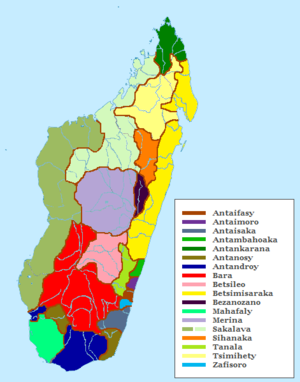
The Merina people are the largest ethnic group in Madagascar. They are the "highlander" Malagasy ethnic group of the African island and one of the country's eighteen official ethnic groups. Their origins are mixed, predominantly with Malayo-Indonesians arriving before the 5th century AD, then many centuries later by Arabs, Africans and other ethnic groups. They speak the Merina dialect of the official Malagasy language of Madagascar.

The Malagasy Uprising was a Malagasy nationalist rebellion against French colonial rule in Madagascar, lasting from March 1947 to February 1949. Starting in late 1945, Madagascar's first French National Assembly deputies, Joseph Raseta, Joseph Ravoahangy and Jacques Rabemananjara of the Mouvement démocratique de la rénovation malgache (MDRM) political party, led an effort to achieve independence for Madagascar through legal channels. The failure of this initiative and the harsh response it drew from the Socialist Ramadier administration radicalized elements of the Malagasy population, including leaders of several militant nationalist secret societies.
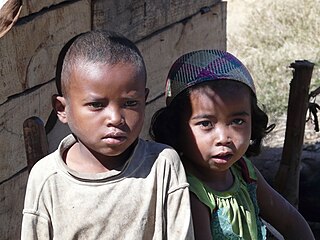
The Betsileo are a highland ethnic group of Madagascar, the third largest in terms of population. They chose their name, meaning "The Many Invincible Ones", after a failed invasion by King Ramitraho of the Menabe kingdom in the early 19th century.

The Tsimihety are a Malagasy ethnic group who are found in the north-central region of Madagascar. Their name means "those who never cut their hair", a behavior likely linked to their independence from Sakalava kingdom, located to their west, where cutting hair at the time of mourning was expected. They are found in mountainous part of the island. They are one of the largest Malagasy ethnic groups and their population estimates range between 700,000 and over 1.2 million. This estimation places them as the fourth-largest ethnicity in Madagascar.

The Sakalava are an ethnic group of Madagascar. They are found on the western and northwest region of the island, in a band along the coast. The Sakalava are one of the smaller ethnic groups, constituting about 6.2 percent of the total population, that is over 1,210,000 in 2014. Their name means "people of the long valleys." They occupy the western edge of the island from Toliara in the south to Sambirano in the north.

Sir Philip Euen Mitchell, was a British Colonial administrator who served as Governor of Uganda (1935–1940), Governor of Fiji (1942–1944) and Governor of Kenya (1944–1952).

The Betsimisaraka are the second largest ethnic group in Madagascar after the Merina and make up approximately fifteen percent of the Malagasy people. They occupy a large stretch of the eastern coastal region of Madagascar, from Mananjary in the south to Antalaha in the north. The Betsimisaraka have a long history of extensive interaction with European seafarers and traders that produced a significant subset with mixed European-Malagasy origins, termed the zana-malata. European influence is evident in the local valse (waltz) and basesa musical genres, which are typically performed on the accordion. Tromba ceremonies feature strongly in Betsimisaraka culture.

The Antanosy is a Malagasy ethnic group who primarily live in the Anosy region of southeastern Madagascar, though there are also Antanosy living near Bezaha, where some of the Antanosy moved after the Merina people conquered Anosy. An estimated 360,000 people identify as Antanosy as of 2013.

The Antesaka, also known as Tesaka, or Tesaki, are an ethnic group of Madagascar traditionally concentrated south of Farafangana along the south-eastern coast. They have since spread more widely throughout the island. The Antesaka form about 5% of the population of Madagascar. They have mixed African, Arab and Malayo-Indonesian ancestry, like the western coastal Sakalava people of Madagascar from whom the clan derives. They traditionally have strong marriage taboos and complex funeral rites. The Antesaka typically cultivate coffee, bananas and rice, and those along the coast engage in fishing. A large portion of the population has emigrated to other parts of the island for work, with an estimated 40% of emigrants between 1948 and 1958 permanently settling outside the Antesaka homeland.
The Antemoro are an ethnic group of Madagascar living on the southeastern coast, mostly between Manakara and Farafangana. Numbering around 500,000, this ethnic group traces its origins back to settlers who arrived from Somalia in the 15th or 16th century. Upon arriving in Madagascar, these settlers converted the Antemoro to Islam; the religion was soon abandoned in favor of traditional beliefs and practices associated with respect for the ancestors, although remnants of Islam remain in fady such as the prohibition against consuming pork. In the 16th century an Antemoro kingdom was established, supplanting the power of the earlier Zafiraminia, who also descended from seafarers.

The Bara people are a Malagasy ethnic group living in the southern part of the central plateaus of Madagascar, in the Toliara Province, concentrated around their historic capital at Ihosy. The Bara are the largest of the island's zebu-herding peoples and have historically lived a semi-nomadic lifestyle, although an increasing proportion are practicing agriculture. Bara society is highly patriarchal and endogamy and polygamy are practiced among some Bara tribes. Young men practice cattle rustling to prove their manhood before marriage, and the kilalaky musical and dance tradition associated with cattle rustlers has gained popularity across the island.
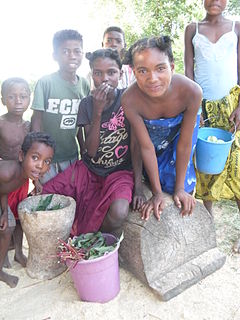
The Mahafaly are an ethnic group of Madagascar that inhabit the plains of the Betioky-Ampanihy area. Their name means either "those who make holy" or "those who make happy", although the former is considered more likely by linguists. In 2013 there were an estimated 150,000 Mahafaly in Madagascar. The Mahafaly are believed to have arrived in Madagascar from southeastern Africa around the 12th century. They became known for the large tombs they built to honor dead chiefs and kings. Mainly involved in farming and cattle raising, they speak a dialect of the Malagasy language, which is a branch of the Malayo-Polynesian language group.
The Antaifasy are an ethnic group of Madagascar inhabiting the southeast coastal region around Farafangana. Historically a fishing and farming people, many Antaifasy were heavily conscripted into forced labor (fanampoana) and brought to Antananarivo as slaves under the 19th century authority of the Kingdom of Imerina. Antaifasy society was historically divided into three groups, each ruled by a king and strongly concentrated around the constraints of traditional moral codes. Approximately 150,000 Antaifasy inhabit Madagascar as of 2013.
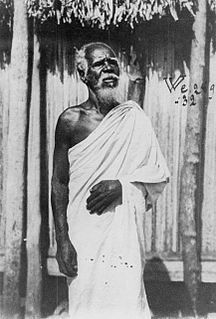
The Antambahoaka are the least numerous ethnic group in Madagascar, numbering around 50,000 in 2013. They inhabit a small region along the southeastern coast of Madagascar near Mananjary and share their origins with the partially Arab Antaimoro people, from whom the group split in the 15th century under a leader named Ravalarivo. Very little is known about the history of this group after its founding. The Antambahoaka speak a dialect of the Malagasy language, which is a branch of the Malayo-Polynesian language group derived from the Barito languages, spoken in southern Borneo.
The Tandroy are a traditionally nomadic ethnic group of Madagascar inhabiting the arid southern part of the island called Androy. Tracing their origins back to the East Africa mainland. In the 17th century however, the Tandroy emerged as a confederation of two groups ruled by the Zafimanara dynasty until flooding caused the kingdom to disband around 1790. The difficult terrain and climate of Tandroy protected and isolated the population, sparing them from subjugation by the Kingdom of Imerina in the 19th century; later, the French colonial authority also struggled to exert its influence over this population. Since independence the Tandroy have suffered prejudice and economic marginalization, prompting widespread migration and intermarriage with other ethnic groups, and leading them to play a key role in protests that sparked the end of President Philibert Tsiranana's administration in 1972.

The Bezanozano are believed to be one of the earliest Malagasy ethnic groups to establish themselves in Madagascar, where they inhabit an inland area between the Betsimisaraka lowlands and the Merina highlands. They are associated with the vazimba, the earliest inhabitants of Madagascar, and the many vazimba tombs throughout Bezanozano territory are sites of pilgrimage, ritual and sacrifice, although the Bezanozano believe the descendants among them of these most ancient of ancestors cannot be identified or known. Their name means "those of many small plaits" in reference to their traditional hairstyle, and like the Merina they practice the famadihana reburial ceremony. There were around 100,000 Bezanozano living in Madagascar in 2013.

The Sihanaka are a Malagasy ethnic group concentrated around Lake Alaotra and the town of Ambatondrazaka in central northeastern Madagascar. Their name means the "people of the swamps" in reference to the marshlands around Lake Alaotra that they inhabit. While rice has long been the principal crop of the region, by the 17th century, the Sihanaka had also become wealthy traders in slaves and other goods, capitalizing on their position on the main trade route between the capital of the neighboring Kingdom of Imerina at Antananarivo and the eastern port of Toamasina. At the turn of the 19th century they came under the control of the Boina Kingdom before submitting to Imerina, which went on to rule over the majority of Madagascar. Today the Sihanaka practice intensive agriculture and rice yields are higher in this region than elsewhere, placing strain on the many unique plant and animal species that depend on the Lake Alaotra ecosystem for survival.
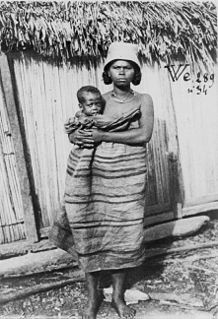
The Tanala are a Malagasy ethnic group that inhabit a forested inland region of south-east Madagascar near Manakara. Their name means "people of the forest." Tanala people identify with one of two sub-groups: the southern Ikongo group, who managed to remain independent in the face of the expanding Kingdom of Imerina in the 19th century, or the northern Menabe group, who submitted to Merina rule. Both groups trace their origin back to a noble ancestor named Ralambo, who is believed to be of Arab descent. They were historically known to be great warriors, having led a successful conquest of the neighboring Antemoro people in the 18th century. They are also reputed to have particular talent in divination through reading seeds or through astrology, which was brought to Madagascar with the Arabs.
Talansan was the location of a battle in Futa Jallon, in what is now Guinea, in which Muslim forces were victorious. The battle was a key event in the jihad in which the Imamate of Futa Jallon was created.
The literature of Madagascar encompasses the oral and written literary arts of the Malagasy people.
